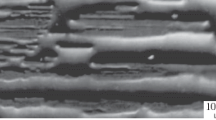Abstract
In the last two decades, processing maps have been developed on a wide variety of materials including metals and alloys, metal matrix composites, and aluminides, and applied to optimizing hot workability of materials and for process design in bulk metal working. Processing maps consist of a superimposition of efficiency of power dissipation and the instability maps, the former revealing the “safe” domain for processing and the latter setting the limits for avoiding undesirable microstructures. The dynamic materials model, which forms the basis for processing maps, is discussed in relation to other materials models. The application of dynamical systems principles to understanding of deterministic chaos in the system will help in achieving a greater degree of microstructural control during processing. The patterns in the hot working behavior as revealed by the processing maps of several classes of alloys relevant to technology are reviewed briefly. Processing maps have also been applied to analyze several industrial problems including process optimization, product property control, and defect avoidance, and a few examples are listed. With the processing maps reaching a matured stage as an effective tool for optimizing materials workability, expert systems and artificial neural network models are being developed to aid and prompt novice engineers to design and optimize metal processing without the immediate availability of a domain expert, and the directions of research in this area are outlined.
Similar content being viewed by others
References
J.J. Jonas, C.M. Sellars, and W.J. McG. Tegart: “Strength and Structure Under Hot Working Conditions,” Metall. Rev., 1969, 14(1), pp. 1–24.
R. Raj: “Processing Map for Hot and Warm Working of Aluminum,” Metall. Trans. 1981, A12, pp. 1089–97.
Y.V.R.K. Prasad, H.L. Gegel, S.M. Doraivelu, J.C. Malas, J.T. Morgan, K.A. Lark, and D.R. Barker: “Modeling of Dynamic Materials Behavior in Hot Deformation: Forging of Ti-6242,” Metall. Trans. A, 1984, 15, pp. 1883–92.
H.L. Gegel, J.C. Malas, S.M. Doraivelu, and V.A. Shende: “Modeling Techniques Used in Forging Process Design,” Metals Handbook, Vol. 14, ASM International, Metals Park, OH, 1987, pp. 417–42.
V.V. Kutumba Rao and T. Rajagopalachary: “Recent Developments in Modeling the Hot Working Behavior of Metallic Materials,” Bull. Mater. Sci., 1996 19, pp. 677–98.
S.V.S. Narayana Murthy, B. Nageswara Rao, and B.P. Kashyap: “Instability Criteria for Hot Deformation of Materials,” Inter. Mater. Rev. 2000, 45(6), pp. 15–26.
Y.V.R.K. Prasad and T. Seshacharyulu: “Modeling of Hot Deformation for Microstructural Control,” Inter. Mater. Rev., 1998, 43, pp. 243–58.
P.E. Wellstead: Introduction to Physical Systems Modeling, Academic Press, London, UK, 1979.
H. Ziegler: “Some Extremum Principles in Irreversible Thermodynamics with Applications to Continuum Mechanics” in Progress in Solid Mechanics, I.N. Sneddon and R. Hill, ed., John Wiley, New York, Vol. 4, 1965, pp. 91–193; also see Thermomechanics, 2nd ed., North-Holland, Amsterdam, The Netherlands, 1983.
I. Prigogine: “Time, Structure and Fluctuations,” Science, 1978, 201, pp. 777–87.
R.C. Hillborn: Chaos and Nonlinear Dynamics: An Introduction for Scientists and Engineers, Oxford University Press, Oxford and New York, 1994.
L.E. Malvern: Introduction to the Mechanics of Continuum Medium, Prentice-Hall, Englewood Cliffs, NJ, 1969, pp. 197–271.
W. Prager: “Viscoplasticity and Locking Solids,” Trans. Soc. Rheology, 1957, 1, pp. 169–75.
F. Montheillet, J.J. Jonas, and K.W. Neale: “Modeling of Dynamic Material Behavior: A Critical Evaluation of the Dissipater Power Co-Content Approach,” Metall. Mater. Trans. A, 1996, 27, pp. 232–35.
S.L. Semiatin and J.J. Jonas: Formability and Workability of Metals: Plastic Instability and Flow Localization, ASM, Metals Park, OH, 1984.
C. Grebogi, E. Ott, and J.A. Yorkee: “Chaos, Strange Attractors and Fractal Basin Boundaries in Non-Linear Dynamics,” Science, 1987, 238, pp. 632–38.
F.B.J. Macmillen: “Non-Linear Dynamics and Flight Control,” Philos. Trans. R. Soc. London, 1998, A356, p. 2167–83.
M.J. Abzug and E.E. Larrabee: Airplane Stability and Control, Cambridge University Press, New York, 1997.
S.H. Strogatz: Non-linear Dynamics and Chaos with Applications to Physics, Biology, Chemistry and Engineering, Addison-Welley, Reading, MA, 1994.
Y.V.R.K. Prasad: “Dynamical Systems Approach for Microstructural Control in Hot Working Processes” in Proceedings of International Symposium on Materials Ageing and Life Management, B. Raj, K.B.S. Rao, T. Jayakumar, and R.K. Dayal, ed., Allied Publishers Ltd., Chennai, India, 2000, pp. 597–604.
Y.V.R.K. Prasad, S. Sasidhara, and V.K. Sikka: “Characterization of Mechanisms of Hot Deformation of As-Cast Nickel Aluminide Alloy,” Intermetallics, 2000, 8/9, pp. 987–95.
N. Kumar: Deterministic Chaos: Complex Chance out of Simple Necessity, Universities Press (India) Ltd., Hyderabad, India, 1996.
Y.V.R.K. Prasad and S. Sasidhara: Hot Working Guide: A Compendium of Processing Maps, ASM International, Materials Park, OH, 1997.
P.K. Sagar, D. Banerjee, K. Muraleedharan, and Y.V.R.K. Prasad: “High Temperature Deformation Processing of Ti-24Al-20Nb,” Metall. Trans. A, 1996, 27, pp. 2593–604.
Y.V.R.K. Prasad, D.H. Sastry, and S.C. Deevi: “Processing Maps for Hot Working of a P/M Iron Aluminide Alloy,” Intermetallics, 2000, 8/9(11), pp. 1067–74.
T. Seshacharyulu, S.C. Medeiros, W.G. Frazier, and Y.V.R.K. Prasad: “Strain Induced Porosity During Cogging of Extra-Low Interstitial (ELI) Grade Ti-6Al-4V,” J. Mater. Eng. Performance, 2001, 10(2), pp. 125–30.
R. Ravi, Y.V.R.K. Prasad, and V.V.S. Sarma: “Development of Expert Systems for the Design of a Hot-Forging Process Based on Material Workability,” Ph.D. Thesis, Indian Institute of Science, Bangalore, India, 2003, 12, 646–52.
Author information
Authors and Affiliations
Rights and permissions
About this article
Cite this article
Prasad, Y.V.R.K. Processing maps: A status report. J. of Materi Eng and Perform 12, 638–645 (2003). https://doi.org/10.1361/105994903322692420
Received:
Issue Date:
DOI: https://doi.org/10.1361/105994903322692420




